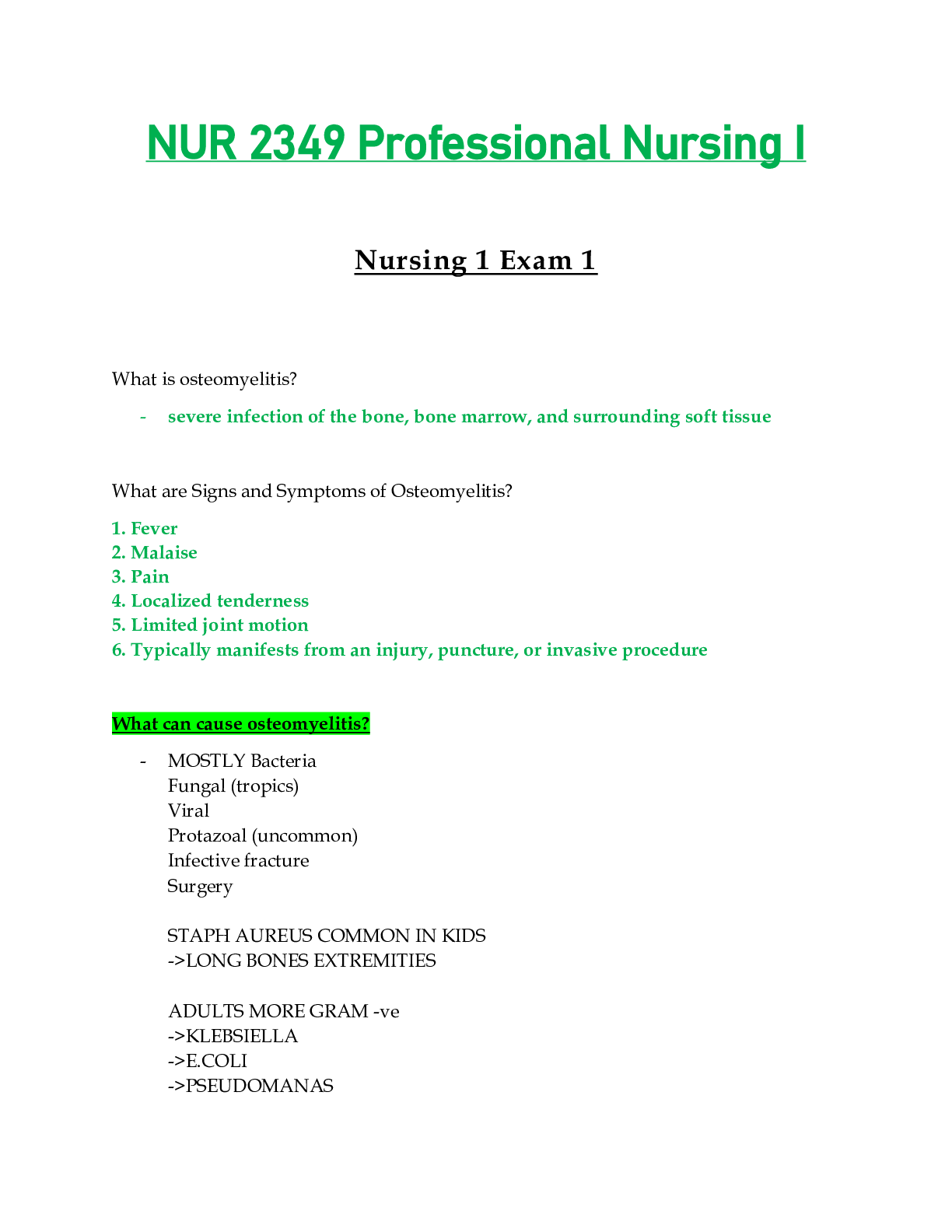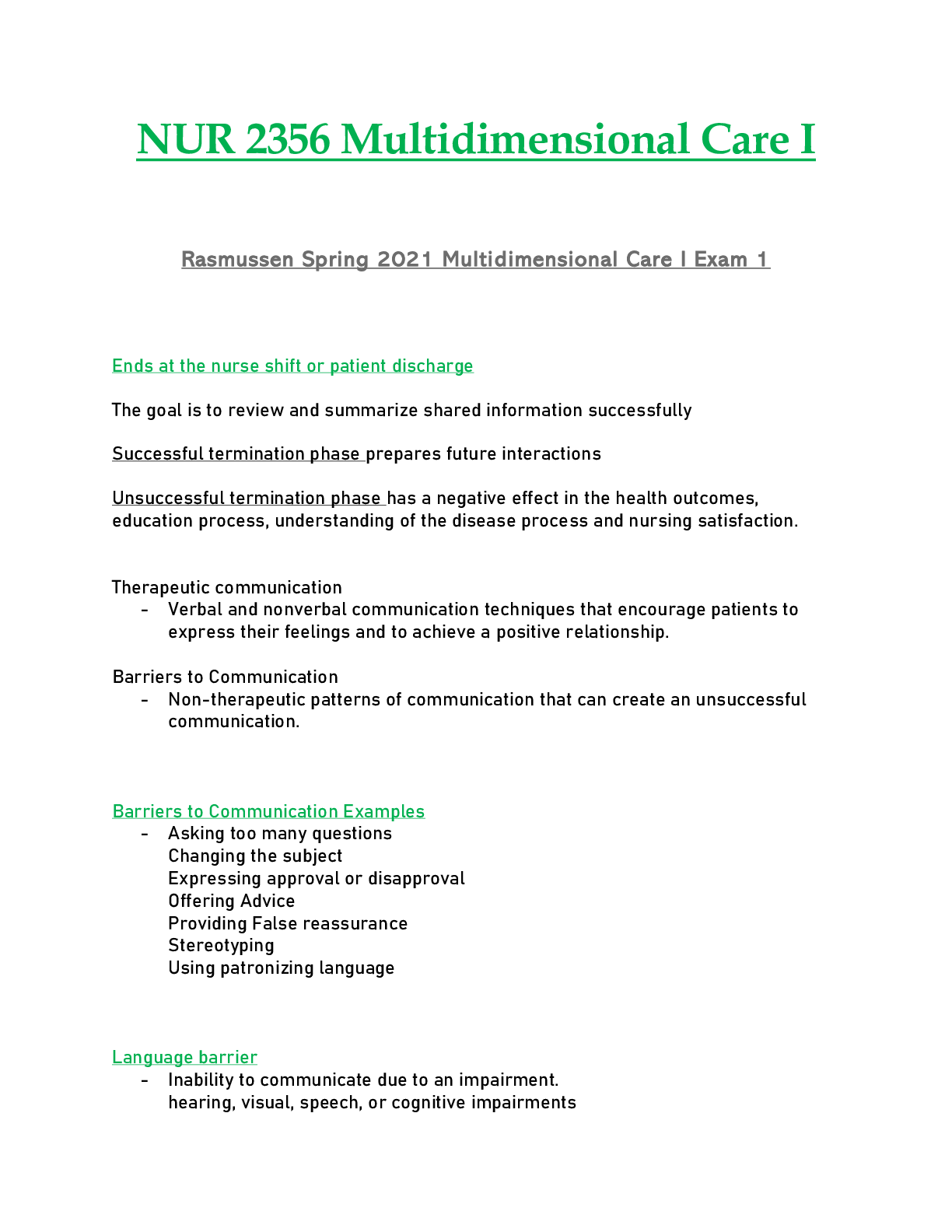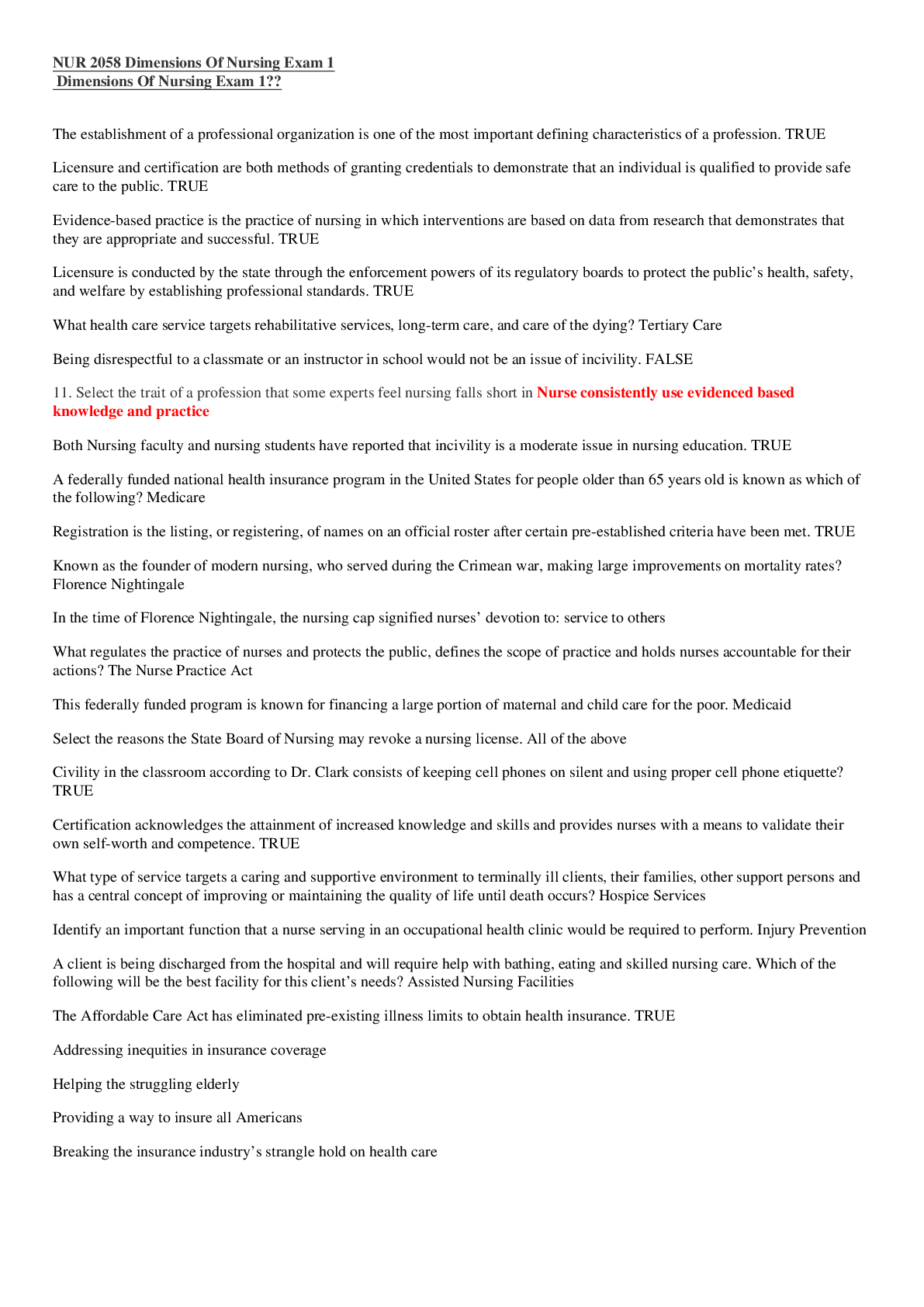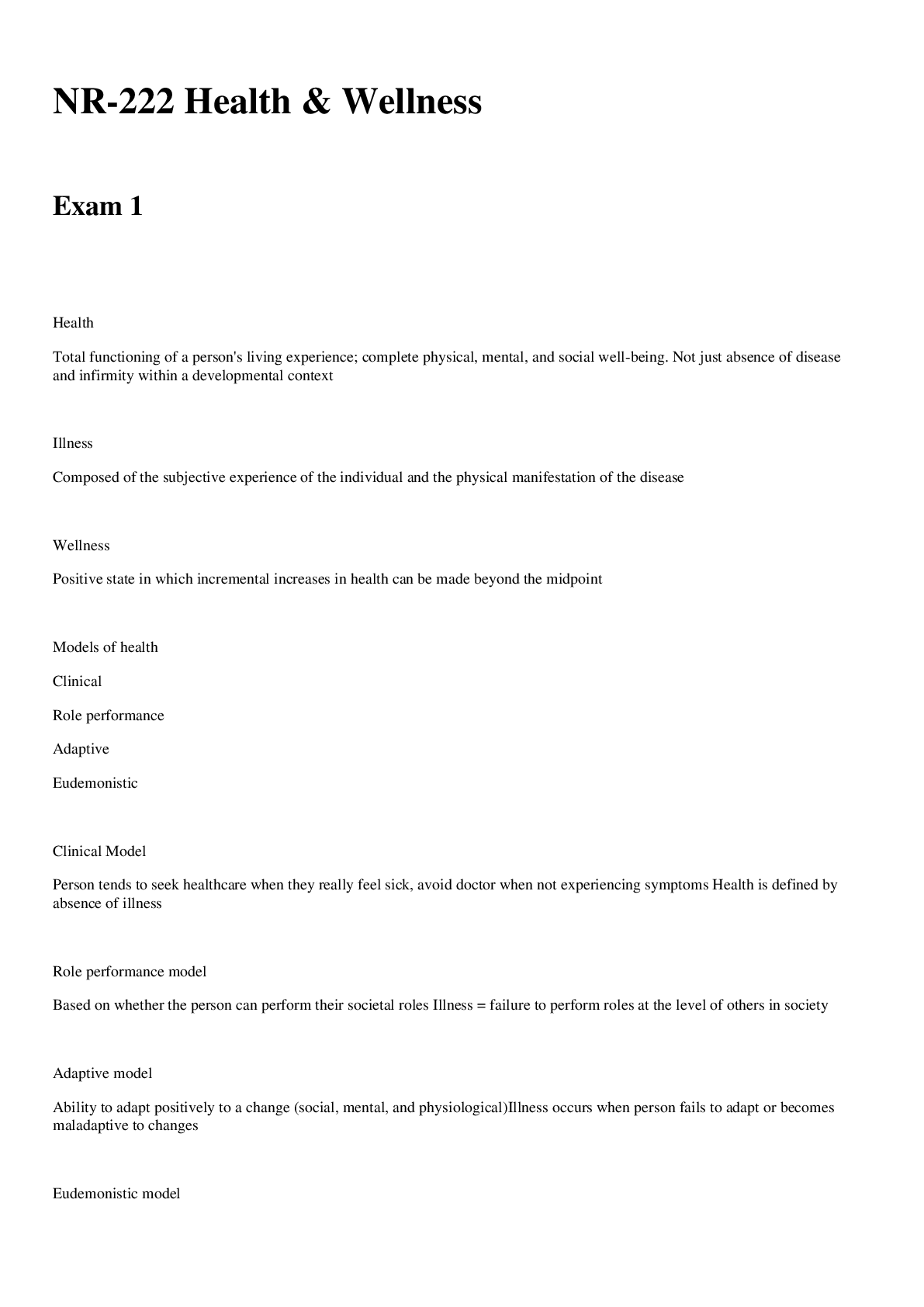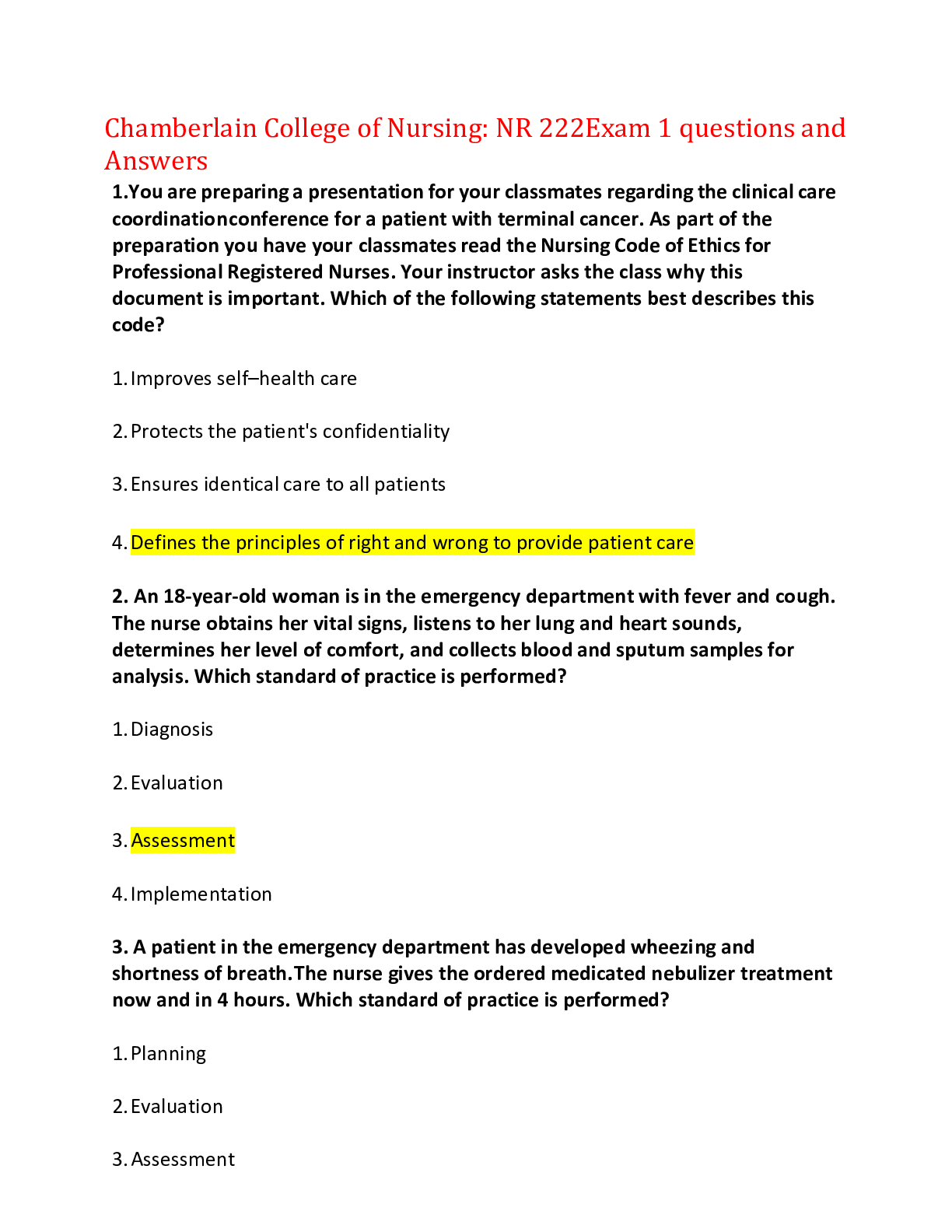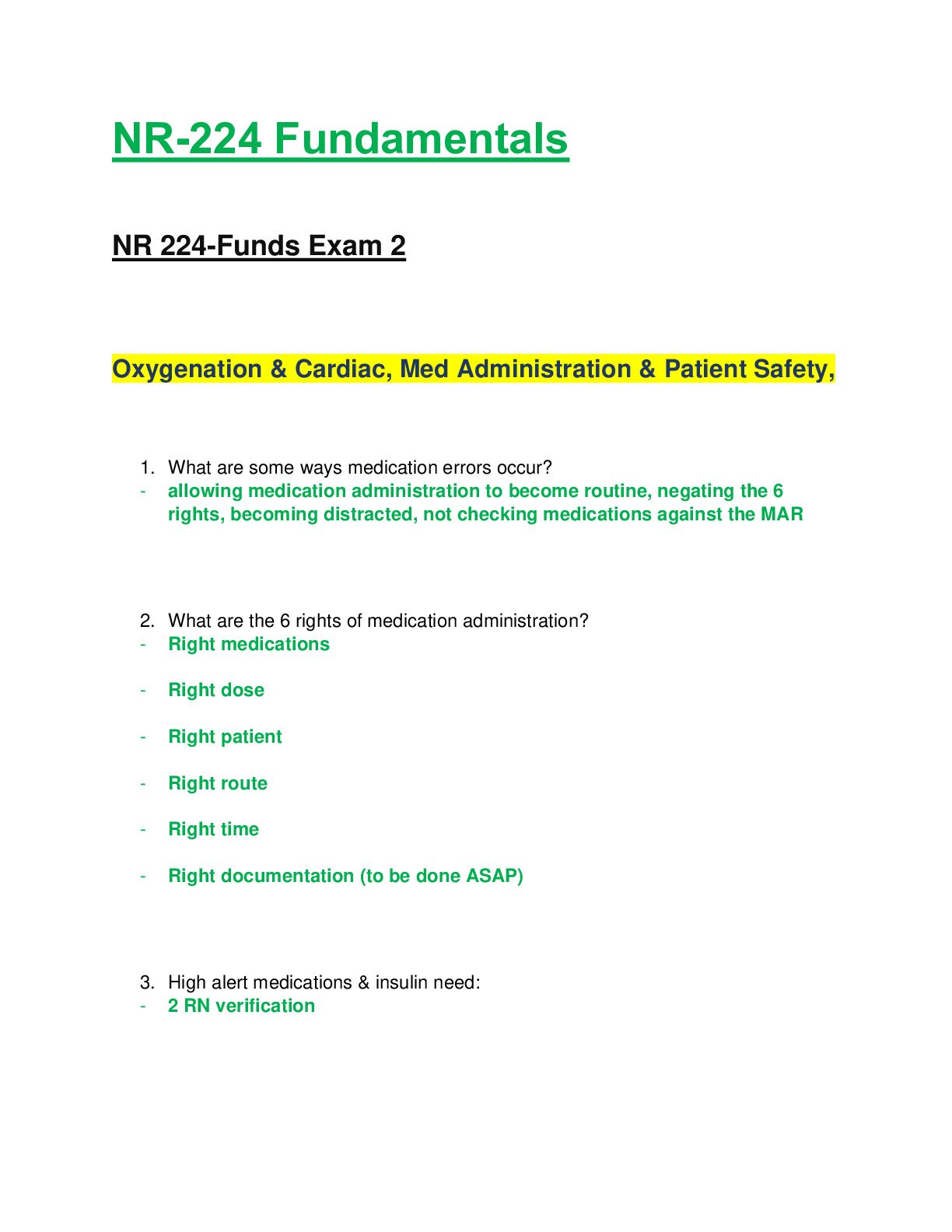*NURSING > EXAM > NR224 / NR 224: Fundamentals Exam 1 (Latest Update) Chamberlain College of Nursing (All)
NR224 / NR 224: Fundamentals Exam 1 (Latest Update) Chamberlain College of Nursing
Document Content and Description Below
NR-224 Fundamentals Exam 1 1. who is ultimately responsible for the patient, even when delegation is involved? - Nurse (RN) 2. what are a nurse’s responsibilities involving delegation? ... - Needing to apply critical thinking to appropriately delegate the care, give clear instructions. 3. What is most important technique to use in preventing and controlling transmission of infection? - Hand washing 4. 6 Components in the Chain of Infection - 5. List and describe the different body defense mechanisms - 6. Describe examples of patients at high risk for infection - 7. What lab result signifies infection when it is elevated? - 8. Having an impaired immune system - 9. The ability to produce disease - 10. Internal transmission such as a parasitic condition in a host such as a mosquito, louse, flea, or ticks - 11. Requires oxygen for survival and for multiplication sufficient to cause disease. - 12. Thrives where little to no oxygen is available - 13. Prevention of growth and the reproduction of bacteria. - 14. Destructive to bacteria - 15. What are the stages of infection? - 16. critical thinking - 17. characteristics of critical thinking - 18. clinical decision making - 19. critical thinking model - 20. Basic level - 21. Complex level - 22. Commitment level - 23. what is needed first before anything else? - ... 24. Interpretation - 25. Analysis - 26. Inference - 27. Evaluation - 28. Explanation - 29. self-regulation - 30. Confidence - 31. Independence - 32. Fairness - 33. Responsibility - 34. risk taking - 35. Discipline - 36. Perservance - 37. Creativity - 38. Curiosity - 39. Integrity - 40. Humility - 41. truth seeking - 42. open-mindedness - 43. analytic approach - 44. systemic approach - B 45. self-confidence - 46. Inquisitiveness - 47. Maturity - maturity. 48. reflective journaling - 49. concept mapping - 50. nursing care plan - 51. nursing process - 52. assess - 53. diagnose - 54. plan - 55. implement - 56. evaluate - 57. subjective data - 58. objective data - 59. observation - 60. open-ended questions - 61. leading questions - 62. back channeling - 63. Probing - 64. direct close-ended questions - 65. admission assessments - ... 66. PQRST - 67. interpreting assessment data - 68. validating assessment data - 69. Incubation Stage - 70. Prodromal Stage - 71. Illness Stage - 72. Convalescence Phase - 73. What are clinical manifestations of localized infection? - 74. What are clinical manifestations of systemic infection? - 75. Describe necrotic tissue, what happens, what process is it apart of? - 76. Describe granulation tissue, when does it happen? Is it good or bad? - 77. Serious Exudate - 78. Sanguineous - 79. Purulent Exudate - 80. What is medical asepsis? - 81. What is surgical asepsis? - 82. When is surgical asepsis used? - 83. What are the 7 principles of surgical asepsis? (1) - 84. What are the 7 principles of surgical asepsis? (2) - 85. What are the 7 principles of surgical asepsis? (3) - 86. What are the 7 principles of surgical asepsis? (4) - 87. What are the 7 principles of surgical asepsis? (5) - 88. What are the 7 principles of surgical asepsis? (6) - 89. What are the 7 principles of surgical asepsis? (7) - 90. What is the difference between sterilization and disinfection? - 91. Standard precautions is the primary strategy to prevent HAI's, what is used and when is it used? - 92. Airborne precautions - 93. Droplet precautions - 94. Contact precautions - 95. Protective environment - 96. When is a positive pressure room used? - 97. Describe procedures when caring for a patient with c. difficle. - d.) 98. How/why are diabetics at higher risk for infection? - 99. As a nurse what areas would we assess specifically for wounds? Why? - 100. Pyrexia - 101. Fever is greater than (adults/children) - 102. Why is a fever beneficial to the body? - 103. What are you assessing for when feeling for a pulse? - 104. What are you assessing for when assessing respirations? - 105. Ventilation - 106. Diffusion - 107. Perfusion - 108. What is the systolic and diastolic blood pressures? - 109. How do you calculate a pulse pressure? - 110. What conditions would you not use an electronic blood pressure measurement? - 111. What are the principles of safe patient transfer and positioning? Principles of Safe Patient Transfer and Positioning - 112. What do you do before moving or transferring a patient? _______ the situation first. - 113. Explain how to prevent lift injuries in health care workers. - 114. Walkers - 115. Canes - 116. Crutches - 117. How do you measure for crutches? - 118. Patients assume a crutch gait by - 119. Crutches on stairs—Which leg goes first when going up? - 120. Crutches on stairs—Which leg goes first when going down? - 121. Sitting in a chair with crutches - 122. Immobility and Respiratory system - 123. Immobility and Cardiovascular system - 124. Immobility and Integumentary system - 125. Immobility and Musculoskeletal system - 126. How do nurses reduce orthostatic hypotension? - 127. How do nurses reduce a patient’s cardiac workload? - 128. How do nurses prevent thrombus formation? - 129. Explain what to do if a patient starts to fall and you do not have a chair nearby: - 130. ... - 131. Describe the epidermis - 132. What are three pressure related factors that contribute to pressure ulcers? Why? - 133. Granulation tissue - 134. Slough - 135. Eschar - 136. Exudate - 137. Necrotic tissue - 138. Friction - 139. Shear force - 140. What is the Braden scale and why do we use it? - 141. Primary Intention of wounds - 142. Secondary intention of wounds - 143. Tertiary intention of wounds - 144. Which one is the most effective for wound healing? - - 146. Stage 2 Wound - 147. Stage 3 Wound - 148. Stage 4 Wound - 149. Stage 5 Wound - 150. What are nursing interventions to help prevent pressure ulcers? - 151. How does urinary incontinence lead to ulcers? - 152. Abrasion - 153. Laceration - 154. Puncture - 155. How often should a patient get a tetanus shot? - 156. Serous Drainage - 157. Serosanguineous Drainage - 158. Sanguineous Drainage - 159. Purulent Drainage - 160. What characteristics do we note about wound drainage? - 161. What nutrient & element is important for wound healing? - 162. When are Montgomery ties utilized? - 163. Describe a hydrocolloid dressing and when it is used. - 164. Describe a Jackson Pratt (JP) drain and when it is used? - 165. Should the bulb of a JP drain be compressed or no? Why? - 166. What is wound dehiscence - 167. What is wound evisceration? - 168. What are the nursing interventions if a wound does eviscerate? - 169. Because you will be a kind, compassionate nurse - you will do what before you rush in and perform a dressing change on a patient? - 170. What must we clean with first before obtaining a wound culture? - 171. Why do we never give antibiotics before getting a culture of anything? - [Show More]
Last updated: 2 years ago
Preview 1 out of 30 pages

Buy this document to get the full access instantly
Instant Download Access after purchase
Buy NowInstant download
We Accept:

Reviews( 0 )
$16.00
Can't find what you want? Try our AI powered Search
Document information
Connected school, study & course
About the document
Uploaded On
Nov 17, 2020
Number of pages
30
Written in
Additional information
This document has been written for:
Uploaded
Nov 17, 2020
Downloads
0
Views
280









